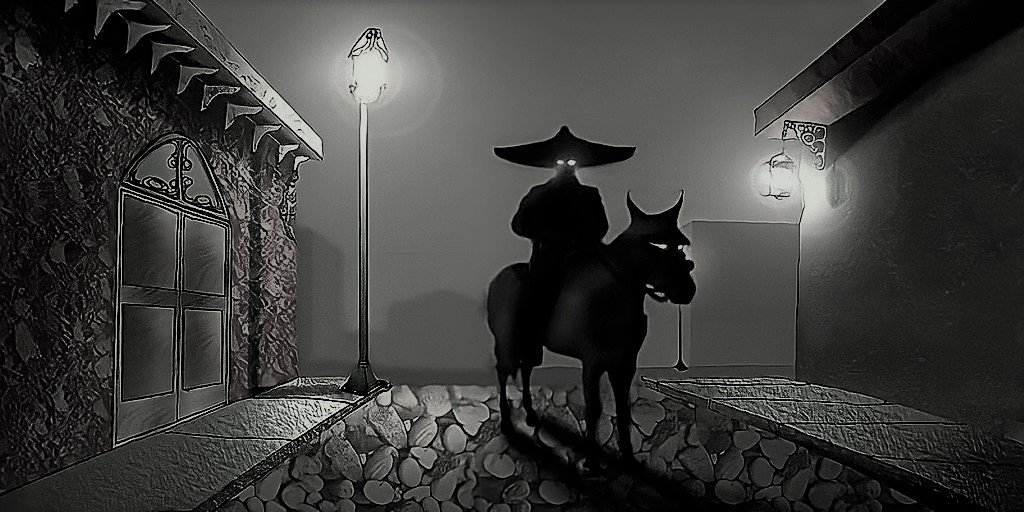The Curse of Giles Corey, Salem, Massachusetts
In 1692 Salem Massachusetts suffered from a bout of mass hysteria known today as the Salem Witch Trials. One of the victims was an 80-year-old man, Giles Corey, who according to legend placed a curse not only on Salem but the Sheriff and all future Sheriff as well. But could this legend actually be true or can we look at historical information to disprove it?
The Salem Witch Trials
In January 1962 in the village of Salem Massachusetts Reverend Samuel Parris’s 9-year-old daughter, Elizabeth Parris began having “fits” that were deemed to be caused by the devil. Elizabeth screamed, barked, spoke in tongues, and contorted her body leaving the village scared and confused.
At the time many believe the devil could infuse others with the powers of witchcraft and those individuals could infect the young to do their bidding. During moments of lucidity, the town begged Elizabeth to reveal who in the town had been working for the devil. Soon, a wave of mass hysteria swept through the town in what is today known as the Salem Witch Trials.
Shortly after Elizabeth began having fits two other girls, Elizabeth’s cousin 11 year-old Abigail Williams, and 12-year-old Ann Putnam Jr. displayed the same symptoms. The girls would go on to accuse over 200 individuals of witchcraft and the following trials ended with the execution of 20.
While these were the original three who helped ignite the witch trials, over the course of that year several other girls would join them in accusations. For a time it seemed as if anyone could be accused and the hysteria and the fear of witches and devils were so ingrained in the villagers that the accusations were taken as fact.
Those accused would end up having to defend themselves at trial with the primary witnesses being the girls whose main evidence was hearsay. Unfortunately most of the time this was enough for the villagers. But for those who were critics of the witch trials and baseless accusations being thrown around, at best they were shunned, and at worst, they were accused themselves.
Accusations Against Martha Corey
During the height of the trials, several villagers believed that the girls were lying about their fits and accusations and weren’t afraid to make it known. One of these villagers was devout churchgoer 72-year-old Martha Corey who lived on the outskirts of the village with her husband 80-year-old Giles Corey.
From some of the very first trials and accusations, Martha was an outspoken critic of not just the trials but also the judges who were allowing the trials to happen. Martha who did not believe in witches or warlocks then accused the girls of lying about their symptoms which painted a target on her back.
After being called liars, two girls including Ann Putnam Jr. claimed that Martha Corey’s spirit had attacked them, something only witches could do. Ann Putnam Jr. would go on to testify in court that Satan had whispered in Martha’s ear, converting her into a witch.
Martha was arrested on March 1692 for the crimes of witchcraft. During questioning Martha was urged to confess but she refused and even laughed at the accusations. Shockingly the mass hysteria had its grip on the town so tightly that Martha’s own husband, Giles Corey testified against her.
On March 24th, 1692, Giles testified that he believed Martha had bewitched him one afternoon when he attempted his prayers. He also claimed that animals on their farm had recently begun acting strangely in her presence and that Martha would often wake up in the middle of the night and pray silently.
Martha was indicted on two counts of witchcraft and after pleading not guilty, was placed in jail in Boston to await trial. Meanwhile, others came forward testifying against Martha and soon Giles himself was accused.
The Death and Curse of Giles Corey
On April 18, 1692, an arrest warrant was issued for Giles Corey after several girls accused him of witchcraft. During his questioning, his accusers, including Ann, Abigail, and three other girls faked having fits whenever he moved his head or arms resulting in the judge having to tie Giles's hands behind his back.
Giles was now against the witch trials and called the girls liars yet by now it was too late. The judge asked whether Giles would plead guilty or not guilty of witchcraft but Giles refused to plea. At the time, if someone was accused of a crime and they did not plead guilty or not guilty then a trial could not occur and put the process in limbo.
It’s widely believed that Giles refused to plea as he knew he would most likely be found guilty by his hysteria-induced peers resulting in his property being taken away. Giles was a wealthy and successful farmer who wanted to leave his property to his sons and not have it end up with the Sheriff as had occurred with others accused of witchcraft.
With Giles's refusal to enter a plea, Judge Samuel Sewall threw Giles in jail for the time being. In September with Giles still refusing to enter a plea, Sewall gave Sheriff George Corwin the go-ahead to use torture to get him to enter a plea something legally allowed called “peine forte et dure” or “strong and harsh punishment”.
Giles was taken to an empty field next to the Salem jail and stripped naked. He was then ordered to lay on the ground and a board was placed over him with several heavy rocks added atop of him by Sheriff Corwin.
Sheriff Corwin would continue adding heavy rocks and even stood on the board himself demanding Giles enter a plea. Each and every time Giles simply cried out for more weight. A crowd had formed and watched as Sheriff Corwin continued the torture and even at one point had to push Giles's tongue back into his mouth as it was bulging out from the weight.
After several days with Giles seemingly knowing his death was only minutes away, he cursed the town of Salen and the Sheriff before demanding more weight. Giles Corey died on September 19th, 1692 from being pressed to death. Three days later Marth Corey was hanged along with 7 others who had been convicted of witchcraft. These were the last hangings of the Salem Witch Trials.
Giles Corey and the Curse Returns
Four years after the death of Giles Corey, the curse he uttered was still fresh in everyone’s mind as a string of natural disasters had scared the villagers. Then on April 12, 1696, Sheriff George Corwin died suddenly of a heart attack at the age of 30.
The following year a day of prayer and fasting was held on January 15th, 1697 as many in the town felt that god was punishing them for the witch trials. Over the next several decades the town attempted to repent and even the girls who led the accusations of witches admitted their lies, although they blamed their lies on the devil.
But the death of Sheriff Corwin or the attempts of repented didn’t seem to satisfy everyone. In 1801 the Howard Street Cemetery was established on the same field where Giles Corey was killed. Shortly after its opening, people began seeing who they believed was Giles Corey. The legend claims that immediately before every natural disaster since 1801, Giles’ ghost can be seen wandering around the cemetery.
A 300-Year-Old Curse
In 1974 Robert Ellis Cahill was elected the new Sheriff of Essex County, Massachusetts which included Salem. Although everything seemed to be going well, in 1978 Robert suffered a heart attack and stroke.
After hearing of Giles Corey’s curse, Robert investigated and gathered all the historical documents he could get his hands on. He discovered that every sheriff he could find information on since Sheriff Corwin had either died in office of heart problems or retired due to a blood disorder. The position of Sheriff had been cursed by Giles Corey.
Today the curse is widely believed to be broken ever since the sheriff’s office moved from Salem to Middleton in 1991. But the question remains, were all the sheriffs since Sheriff Corwin truly cursed by Giles Corey?
Did it Happen?
The story of the witch trials, Martha Corey, and Giles Corey were all true and are documented. There are ample historical documents proving it all happened but what there isn’t documented proof of is Giles Corey’s last words. Today it’s widely accepted his last words cursed the sheriff and Salem but there is nothing in any historical document or source that proves this to be the case.
Either way, I still researched all the sheriffs since Sheriff Corwin using burial information, books on the history of Salem, old newspapers, and the detailed and well-sourced website HistoricIpswich.com.
As many of the sheriffs would also have high-ranking positions in other political areas in the county or state there is, at times, detailed information on them. From all this, I have been able to determine that the curse is not even close to being real.
The Sheriffs of Salem 18th Century
Here is a list of all the Sheriffs of Essex until 1867 based on the 1888 book the History of Essex County, Massachusetts:
The list above does contain some errors but it gives us good starting points with an updated list available on Wikipedia.
William Gedney - born in 1668 and died in 1729 at the age of 60. Was appointed Sheriff from 1696 to 1715 when he retired.
Thomas Wainwright - listed as Sheriff in 1702, was co-sheriff with William Gedney but could find no information on him at all.
Daniel Denison - listed as Sheriff in 1708 but this is an error as Daniel Denison was not the sheriff in 1708 since he died in 1682. There are no other records of a Daniel Denison in Salem or Essex county. This Daniel Denison was a Major-General and great-grandfather to John Denison who was sheriff in 1715.
John Denison - born in 1689 died November 25th, 1724 at the age of 35. Was appointed sheriff in 1715 and died while in office in 1724. His death was giving credence to the curse until I discovered he most likely died due to an unknown genetic illness.
His father, John Denison died at the age of 23 in 1689 from an unknown listed cause and his grandfather, also John Denison, died at the age of 31 in 1671 from an unknown listed cause.
Benjamin Marston - born February 24, 1697, and died May 22nd, 1754 at the age of 57. Took over as Sheriff in 1724 after John Denison’s death but was already co-sheriff with John since 1724. Was sheriff for 21 years until 1745 when he retired and moved away.
Robert Hale - born February 12, 1702, and died March 20th, 1767 at the age of 65. Appointed sheriff in 1746 and retired in 1763. The cause of death four years later is not listed anywhere.
Richard Saltonstall - born March 5th, 1732, and died October 5th, 1785 at the age of 53. Appointed sheriff in 1763 and quit in 1776 as he was loyal to England during the revolutionary war. Moved to England in 1776 and lived the rest of his life there.
Michael Farley - born in 1719 and died June 20th, 1789 at the age of 70. Appointed Sheriff sometime between 1775 and 1777 until 1789. Died while in office but no cause of death was given other than he was 70 years old.
The Sheriffs of Salem 19th Century
Bailey Bartlett - Born January 29th, 1750, and died September 9th, 1830 at the age of 80. Appointed Sheriff on July 1st, 1789, and left the position on December 5th, 1811. He was asked to return as Sheriff and was re-appointed to the position on June 20th, 1812 where he stayed until his death.
Bartlett had resigned prior to his death but newspaper records show his resignation was accepted the day before his death. No cause of death was given other than he was 80 years old.
Joseph E. Sprague - Born September 9th, 1782, and died February 22nd, 1852 at the age of 69. Appointed Sheriff in September 1830 and stayed Sheriff until his death in 1852. His death was listed as having been caused by apoplexy.
Frederick Robinson - Born August 7th, 1799, and died January 22nd, 1882 at the age of 82. Sheriff from 1852-1853. The only information I could find list was a newspaper stating he had been removed from his position and replaced by Thomas E. Payson in 1853
Thomas E. Payson - Born June 24th, 1813, and died August 24th, 1877 at the age of 64. Appointed Sheriff in 1853. In 1856 the law changed and sheriffs were no longer appointed and now had to win an election. 1856 was the first election and Thomas E. Payson lost to James Cary.
James Cary - Born December 27th, 1819, and died November 7th, 1893 at the age of 73. Sheriff from 1857 to 1866 when he lost the election for Sheriff to Horatio G. Herrick.
Horatio G. Herrick - born October 28th, 1824, and died April 18th. 1904 at the age of 80. Sheriff from 1866 to 1892. Won every election until 1892 when he refused to rerun again.
The Sheriffs of Salem 20th Century
Samuel A Johnson - born in 1848 and died in 1920 at the age of 72. Sheriff from 1892 to 1920 when he died in office. Some sources say he died in 1919 but burial records and newspapers show he died in 1920. Patrick F. Tierney was appointed by the governor as interim Sheriff in 1920 until Arthur G. Wells won the election that same year.
Arthur G. Wells - Born September 25th, 1867, and died September 1930 at the age of 62. Sheriff from 1921 to 1930. Died in office with no cause of death listed other than that he was 62 years old.
Frank E. Raymond - Born in 1882 and died August 9th, 1960 at the age of 78. Sheriff from 1930 to 1952 when he was forced into retirement due to a law preventing him from keeping his post past the age of 70.
Earl Wells - Born June 17th, 1893, and died April 27th, 1964 at the age of 70. Sheriff from 1953 to 1964 when he died in office. No cause of death was listed. Earl was deputy sheriff during Frank E. Raymond’s tenure.
Roger E. Wells - born February 7th, 1929, and died July 10th, 1992 at the age of 63. Sheriff from 1964 to 1974. Roger E. Wells was the son of Earl Wells and deputy sheriff at the time. After his father’s death, he expected to be chosen as the interim Sheriff until the election but the Governor chose William J. Casey instead.
This led to a mass exodus with Roger and over a dozen deputies quitting. Roger E. Wells then won the election that year. In 1974, he declined to run again after feeling “displeased with the courts, the jail system, and… penal reform.”
Sheriff Robert Ellis Cahill’s Curse
Finally, we come to Robert Ellis Cahill, the sheriff who claimed the curse of Giles Corey was real. Robert Ellis did retire early due to a heart attack and stroke 3 years into his tenure. He was sheriff from 1975 to 1978. After that, he became a prolific writer of books focused on the folklore and history of Massachusetts and Salem.
As we can see from the listed sheriffs, no one died from any mysterious causes and no one’s cause of death or retirement was listed as from heart problems or blood disorders. Looking at the ages of the Sheriffs, all except Corwin and Denison died at ages that were average or near average for the time.
It’s more likely Robert Cahill heard about the curse, believed it, and spread it to a wider audience in his books. Maybe he did stumble upon the two sheriffs who died at a young age or maybe he heard rumors of other sheriffs having heart problems and just believed it since the availability of information in the 1970s/80s isn’t the same as today.
Either way, even if Giles Corey’s final words were to curse Salem and its Sheriffs, the curse never worked and the Sheriffs of Essex County including Salem, Massachusetts were always safe.
Other Sources
Learn a Little Bit of Everything!
Myths, Mysteries, & Monsters


















